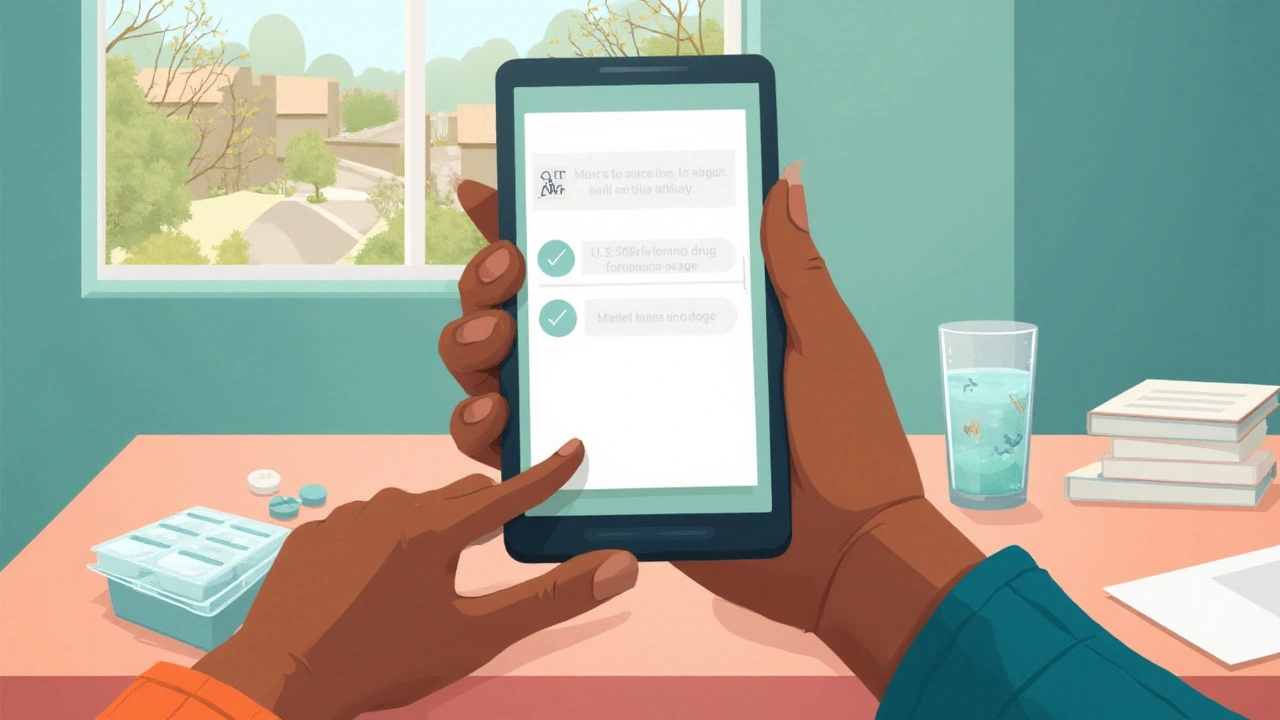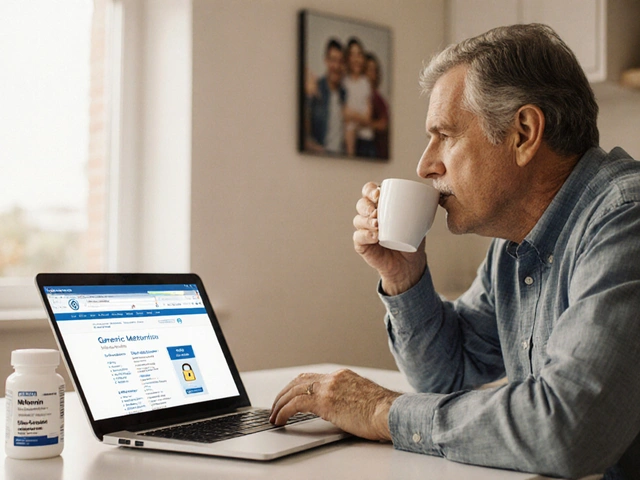
You typed Xyzal because you want something specific-fast relief, the exact dosing, real side effects, where to buy, or the official info without a scavenger hunt. Here’s the straight path. I’ll show you the quickest way to the right pages (brand site, labels, savings, NZ data), give you plain‑English rules for safe use, and help you decide if levocetirizine is the right fit or if another antihistamine is smarter for your situation. No fluff, just what you need to act today.
Get There Fast: The Exact Pages People Mean When They Search “Xyzal” (US and NZ)
Different people mean different things when they type “Xyzal.” Some want the official coupon. Some want the dosing chart for kids. Others want the drug label, or to check if the brand exists in New Zealand. Use the paths below to land on the right page in seconds.
If you’re in the United States (OTC brand):
- Official brand homepage (product overview): In your browser, type: Xyzal official site. Open the result that clearly says the brand name and reads like a consumer page (you’ll see product tiles like “Allergy 24HR”). Look for tabs like “How It Works,” “Dosing,” “Where to Buy,” and “Savings.”
- Night vs Day version: Search: Xyzal Nighttime. You’ll see a page that looks similar to the main brand site but marketed for evening use. It’s the same active ingredient (levocetirizine). Expect a simple message: take it in the evening to reduce next-day drowsiness risk.
- Official dosing chart (adults and kids): Search: Xyzal dosing chart. Open the brand page that lists age bands (adults/children). You should see 5 mg once daily for adults and teens, 2.5 mg once daily for 6-11 years, and 1.25 mg once daily for younger children (liquid). If a chart shows anything wildly different, back out-likely not official.
- Coupon / savings card: Search: Xyzal coupon or Xyzal savings. The official page usually sits near the top with a clean, brand-styled layout and a simple form or download button. Avoid coupon farms that ask for too much personal info or software downloads.
- FDA-approved label (the definitive details): Type: DailyMed levocetirizine label. Open the DailyMed result (United States National Library of Medicine). Look for a header with “levocetirizine dihydrochloride” and sections like Indications, Dosage and Administration, Warnings, Adverse Reactions. This is the gold standard for US labeling.
- What to look for on the label page:
- Dosage: Adults and ≥12 years: 5 mg once daily in the evening. 6-11 years: 2.5 mg once daily. 6 months-5 years: 1.25 mg once daily (oral solution).
- Renal impairment: dose reductions or extended dosing interval; not recommended in end-stage renal disease or dialysis.
- Somnolence: appears in about 6% of adults vs ~2% on placebo in trials.
If you’re in New Zealand (what to ask for, where to check):
- Check NZ availability: The brand name “Xyzal” is not commonly stocked here. Ask your pharmacist for “levocetirizine 5 mg” (common brand: Levrix). If they don’t have it, they can often order it in quickly.
- NZ data sheet (the local technical document): Search: Medsafe levocetirizine data sheet. Open the page that clearly shows an approved “Data Sheet” with sections similar to a medicine’s SmPC-Indications, Dosage, Contraindications, Precautions. This is the official NZ reference for prescribers and pharmacists.
- Consumer medicine info (plain-language NZ guidance): Search: Medsafe levocetirizine consumer information or NZ consumer leaflet levocetirizine. Open the leaflet that explains dosing, side effects, and warnings in simple terms.
- NZ Formulary (NZF) monograph: Search: NZF levocetirizine. Open the New Zealand Formulary entry. You’ll see dosing advice, renal adjustments, and clinical notes used by NZ clinicians.
- Subsidy status: Search: Pharmac levocetirizine. You’re looking for a page indicating whether levocetirizine is funded. As of 2025, expect limited or no subsidy for common OTC-strength antihistamines like levocetirizine; check the current listing for your exact brand and pack.
- Where to buy in NZ: Ask at your local pharmacy counter or search your pharmacy’s site for “levocetirizine 5 mg tablets” or “oral solution.” If they suggest cetirizine or fexofenadine, that’s normal-pharmacies often guide you to a close alternative if stock is out.
For Europe or elsewhere: Search: levocetirizine SmPC plus your country name. Open the summary of product characteristics (SmPC) from the national medicines regulator or the EMA. The SmPC mirrors the official dosing, warnings, and adverse effects for your region.
Quick visual cues so you know you’re in the right place:
- Official brand pages: Clean design, consumer language, product images, clear “Savings” or “Where to buy.”
- Label/data sheets: Dense text, numbered sections (e.g., 4.2 Posology), clinical tone, tables for dose adjustments.
- Government/authority pages: .gov or regulator logos (FDA, Medsafe), minimal marketing language.
When in doubt: If a site pushes pop-ups, asks for your credit card before showing basic info, or looks sloppy, back out and choose another result with a recognizable authority (regulator, formulary, or the brand itself).

Use It Right: Dosing, Safety Rules, and When Not to Take Levocetirizine
Levocetirizine is a second‑generation antihistamine designed to work 24 hours. It’s marketed as less sedating than first‑generation options, but it can still make some people drowsy-especially at the start or if you have other sedating meds onboard. Treat it with respect and you usually get strong relief with minimal hassle.
What it helps: Seasonal and perennial allergic rhinitis (sneezing, runny/itchy nose, itchy/watery eyes) and chronic idiopathic urticaria (hives). That’s from core labeling used by regulators like the FDA and Medsafe.
How fast it works and how long it lasts: Most people feel benefit within about 1 hour, with a steady 24‑hour effect. Peak relief tends to settle in after a few doses if symptoms are heavy.
Standard dosing (from US and NZ technical documents):
- Adults and adolescents ≥12 years: 5 mg once daily, evening preferred.
- Children 6-11 years: 2.5 mg once daily, evening.
- Children 6 months-5 years: 1.25 mg once daily (oral solution). Some regions start at 2 years-check your local leaflet and ask your pharmacist.
Kidney function matters: Levocetirizine is cleared mainly by the kidneys. If your eGFR/creatinine clearance is below about 50 mL/min, you may need a lower dose or to take it every other day. In severe renal impairment and end‑stage kidney disease, levocetirizine is not recommended. This comes straight from the FDA label and the Medsafe Data Sheet. If you have kidney disease, don’t guess-get dosing confirmed before starting.
Alcohol and other sedatives: Skip alcohol or keep it very light until you know how you respond. Combining with benzodiazepines, opioids, or sleep aids increases sedation risk. If your job needs sharp focus (drivers, machine ops), trial your dose on a quiet evening first.
Pregnancy and breastfeeding: There’s no strong signal of harm in human data, but evidence is limited. Levocetirizine passes into breast milk. If pregnant or breastfeeding, talk with your midwife, GP, or pharmacist about options (many clinicians start with loratadine or cetirizine in pregnancy due to more established data). Decisions here are personal-get advice.
Allergy and intolerance: If you’ve reacted badly to cetirizine before (rash, severe drowsiness), be cautious-levocetirizine is a closely related molecule. Start on a day you can monitor how you feel.
When not to take it (or when to pause and ask):
- Severe kidney impairment or dialysis (get medical guidance; often not recommended).
- Age below your country’s approved threshold (check the local leaflet; NZ vs US can differ for toddlers).
- Known hypersensitivity to levocetirizine or any component of the product.
- Mixing with strong sedatives without medical advice.
Common side effects (what shows up in trials): Drowsiness/somnolence (around 6% in adults vs ~2% on placebo in US trials), dry mouth, fatigue. Less commonly, headache or GI discomfort. Serious reactions are rare but seek care if you notice hives that worsen, swelling of face/lips/tongue, breathing trouble, chest tightness, or a severe rash.
Night vs day dosing: Labels often suggest evening dosing to reduce the chance you feel sleepy at work or school the next day. If you’re one of the lucky ones who never feels drowsy, morning dosing is fine-consistency helps more than clock‑watching.
Practical rules of thumb:
- Start on an evening when you don’t need to drive.
- If your nose runs most in the morning, dose the night before.
- Allergy seasons swing-keep a 2-4 week supply ready before peak pollen.
- Hives often need steady daily use for best control; don’t skip days.
Fast “Should I use levocetirizine?” check:
- You want strong symptom relief with once‑daily dosing.
- You didn’t love how cetirizine made you feel, but you want similar power (levocetirizine is related, often just as strong).
- You don’t tolerate fexofenadine’s feel or you need more itch control.
- You can avoid alcohol and heavy machinery until you know your response.
When to switch tracks: If you’re groggy on day 3, consider fexofenadine (usually least sedating) or loratadine/desloratadine. If nasal blockage is the main misery, pair your antihistamine with a steroid nasal spray (fluticasone or budesonide)-that combo is often the game‑changer, per standard allergy guidelines used by clinicians.
Credible sources behind the numbers: The dosing and safety above reflect the US FDA Prescribing Information (via DailyMed), the Medsafe New Zealand Data Sheet and Consumer Information, the New Zealand Formulary monograph, and EU SmPCs. These are primary sources used every day by pharmacists and doctors.

Compare, Save, and Solve Problems: Alternatives, Costs, FAQs, and Next Steps
All antihistamines aren’t the same. Here’s how levocetirizine stacks up, how to keep costs down, and how to fix the most common problems people run into.
Levocetirizine vs other popular options:
- Levocetirizine (Xyzal/Levrix): Potent symptom control; once daily; more likely to cause drowsiness than fexofenadine, similar to or a touch more than cetirizine for some. Great for itch and hives.
- Cetirizine (Zyrtec and generics): Very similar effect profile; often first‑line in hives; slightly higher drowsiness rates for some users; very affordable generics.
- Fexofenadine (Allegra and generics): Least sedating of the bunch; sometimes a bit less potent for itch; often taken twice daily in some regimens.
- Loratadine (Claritin) / Desloratadine: Lower sedation; solid for mild‑to‑moderate hayfever; may feel gentler but sometimes less robust for severe symptoms.
Best for / Not for quick guide:
- Best for: Strong, steady relief with once‑daily dosing; itchy hives; nighttime dosing preference; when cetirizine helped but felt a bit off.
- Not for: People with severe kidney disease; those who must avoid any sedation (consider fexofenadine); toddlers if your country’s labeling doesn’t approve it at that age.
Cost and availability tips (2025):
- United States: Generics are widely available; store brands often match the brand’s strength for less. Use the official savings page if you prefer the brand.
- New Zealand: Ask for levocetirizine 5 mg generics (e.g., Levrix). Prices vary by pharmacy. If it isn’t in stock, they can usually order it in a day or two. Funding via PHARMAC is limited for typical allergy doses-confirm for your exact product.
- Compare per‑dose, not per‑pack: A 30‑tablet box once daily equals a month’s supply. Bigger packs usually drop the per‑dose cost.
Safe‑use checklist before you start:
- Confirm your kidney function if you have renal disease; adjust dose accordingly.
- Plan your first dose on an evening with no driving or big tasks.
- List your sedating meds (sleep aids, opioids, benzos) and ask a pharmacist if there’s a risk.
- Decide your goal: hayfever daily control or rescue for hives-consistency differs.
- For kids, choose the age‑appropriate form and measure with a dosing syringe.
Mini‑FAQ
- Can I take levocetirizine with a nasal spray? Yes. Pairing with an intranasal steroid (like fluticasone) often tackles congestion better than either alone. This combo is a common guideline‑backed move for moderate-severe allergic rhinitis.
- Does “Nighttime” Xyzal have extra ingredients? In the US, the “Nighttime” positioning is mainly about when to take it. Check the box-don’t assume added sleep aids. If you see extra actives you don’t want, pick the regular version.
- Will it knock me out? Most people do fine. About 1 in 16 adults report drowsiness in trials. If you’re sensitive, take it after dinner and reassess after 2-3 days.
- Is it safe long‑term? For chronic allergies or hives, long‑term daily use is common under clinician guidance. If you need it daily for months, check in with your GP to confirm the plan and consider add‑ons (like nasal steroids) or triggers to address.
- What if my eyes are the worst part? Add lubricating drops or an antihistamine eye drop (ketotifen). Oral antihistamines help, but eye‑specific drops can be a big upgrade for itch and watering.
- Can I take it as needed? Yes for intermittent symptoms, but daily use works better for steady seasonal triggers. For hives, daily is typically recommended until the episode settles.
Troubleshooting common problems
- Still congested: Oral antihistamines don’t unblock noses well. Add a steroid nasal spray; give it a week for full effect.
- Too sleepy: Switch to morning dosing or change to fexofenadine. Also double‑check alcohol and other sedatives.
- Not strong enough for hives: Talk to your GP. Many guidelines allow higher doses of certain second‑gen antihistamines for chronic urticaria under supervision. Don’t up‑dose on your own.
- Dry mouth or headache: Hydrate, try evening dosing, or switch molecules if it persists.
- Drug interactions: While levocetirizine has few major interactions, additive sedation is the key risk. Bring your med list to the pharmacy for a 2‑minute check.
Decision snapshots for quick choices
- You need zero drowsiness: Try fexofenadine first.
- You want strong itch relief fast: Levocetirizine or cetirizine are great starts.
- Your nose is blocked more than it’s runny: Add or start a steroid nasal spray; keep an oral antihistamine if eyes/itch are bad.
- On a tight budget: Store‑brand generics usually match the brand molecule for less.
- In New Zealand and can’t find “Xyzal”: Ask for levocetirizine 5 mg (Levrix or other generic). If unavailable, consider fexofenadine or cetirizine as alternatives.
Next steps
- US: Grab the official dosing chart and, if you want the brand, download the savings offer. If you prefer cheaper generics, compare per‑tablet costs at your local pharmacy or reputable online retailer.
- NZ: Ask at the pharmacy for levocetirizine 5 mg or the oral solution for kids. If stock is tight, consider fexofenadine or cetirizine today and ask them to order levocetirizine in.
- Anyone with kidney disease, pregnancy, or breastfeeding: Get a quick thumbs‑up from your clinician or pharmacist on dose and timing before starting.
- If symptoms are heavy: Pair with a steroid nasal spray and reassess in 7-10 days.
Why you can trust this guidance: The dosing bands, safety cautions, and side‑effect rates are taken from primary sources clinicians use every day: FDA Prescribing Information via DailyMed, the Medsafe New Zealand Data Sheet and Consumer Information, and the NZ Formulary. If your pack leaflet differs from what’s here, follow the leaflet for your exact product-manufacturers sometimes vary excipients and instructions by market.
If you only needed one thing from this page-like the coupon, the kid dosing chart, or the NZ data sheet-use the search phrases above and you’ll land on the right page in a few seconds. If you needed the whole picture, you’ve now got the rules, the comparisons, and a clean plan to get relief without surprises.
Write a comment
Your email address will not be published.





18 Comments
So… you’re telling me the universe just… handed us this? Like, a god-tier guide to Xyzal? I’m not crying, you’re crying. This isn’t a post-it’s a spiritual awakening wrapped in a PDF. Levocetirizine is the silent monk of antihistamines, you know? Quiet, disciplined, never overpromises… just… delivers. I’ve been taking it since 2018. No drama. No chaos. Just… peace. And now I know where to find the NZ data sheet. My soul is full.
OMG I’ve been using Xyzal for 3 years and I THOUGHT the nighttime version had melatonin??!!?? I just looked it up-NOPE. Just marketing. I feel so betrayed. Also, why does everyone keep saying ‘levocetirizine’ like it’s a spell? It’s just a fancy word for Zyrtec’s quieter cousin. And why is no one talking about how the NZ formulary is a PDF from 2012?? That’s not ‘official’-that’s archival.
There’s something beautiful about how this post doesn’t just give you info-it gives you permission to trust yourself. So many of us have been Googling ‘Xyzal side effects’ at 2 a.m. while panicking about a runny nose. This is the calm voice we didn’t know we needed. I’ve been on this med for 5 years, and I never knew about the DailyMed link. Thank you for not talking down to us. 🙏
Just a quick note: if you're in Canada, Xyzal is prescription-only unless you get the 5mg generic (which is fine). Also, the kids' liquid? Always use the syringe. I once used a teaspoon and my 4-year-old looked like a zombie for 8 hours. Not worth it. And yes-steroid spray + antihistamine is the dream team. My kid's allergies? Gone.
Let’s be real-this whole post is just a glorified ad for the brand. Who even uses DailyMed? That’s for pharmacists who still use fax machines. And don’t get me started on ‘Medsafe’-New Zealand’s entire health system runs on duct tape and hope. Also, why is no one mentioning that levocetirizine is just a racemic mirror of cetirizine? The FDA approved it because Big Pharma needed a new patent window. The difference? A 0.5% drop in drowsiness and a 300% price hike. This isn’t science-it’s capitalism in a white coat.
Wait so the ‘Nighttime’ version is just… the same pill? Like… I paid extra for that? And now I’m supposed to believe the NZ formulary is ‘official’? That thing looks like it was typed in Word 97. Also, I just took it at 8 a.m. and now I’m napping on my keyboard. Who designed this system? I’m starting to think the pharmaceutical industry is just a cult with better packaging.
Let me tell you what they don’t want you to know. The FDA doesn’t regulate OTC meds the same way as prescription. That ‘savings card’? It’s a trap. They collect your data, sell it to insurers, then jack up your premiums. And the NZ data sheet? Totally controlled by the same pharma lobby that pushed 5G conspiracies. This isn’t medicine-it’s surveillance with a side of antihistamine. You think you’re getting relief? You’re just another data point in a billion-dollar algorithm. Wake up.
Hey, just wanted to say this is one of the clearest, most helpful posts I’ve seen in a long time. I’ve got seasonal allergies and always felt overwhelmed by all the options. The comparison chart? Gold. And the kidney warning? I didn’t even know that mattered-I’ve got stage 2 CKD and now I’m calling my pharmacist tomorrow. Seriously, thank you for taking the time to lay this out so nicely. You made a scared person feel a little less lost.
While the structure of this post is… aesthetically pleasing, it lacks critical contextual analysis. The omission of pharmacoeconomic data is egregious. Furthermore, the normalization of evening dosing as a ‘preference’ ignores circadian pharmacokinetics and reinforces neoliberal individualism in medication adherence. The use of ‘you’ as a rhetorical device is manipulative-this is not empowerment; it’s behavioral conditioning disguised as utility. Also, why no mention of the 2023 Lancet meta-analysis on histamine receptor polymorphisms? 🤔
i just wanted to say… thank you. i’ve been on this med for years but never knew where to find the real info. i’m not great with tech and always got lost in ads. this felt like someone sat with me and walked me through it. also… the kidney thing? i didn’t know. i’ll get my bloodwork checked. you didn’t scare me, you just… helped. that means a lot.
As someone who’s lived in five countries, I can confirm: this is exactly how you navigate global meds. The US, NZ, EU-they all have their own systems, but the core science is the same. The key is knowing where to look, not what to believe. I’ve shown this to my expat friends in Berlin and Tokyo. They were stunned. This isn’t just helpful-it’s a public service. Well done.
Wow. Just… wow. You made me feel like an idiot for not knowing about DailyMed. And now I’m wondering-how many other meds are we taking blindly? This isn’t just about Xyzal. This is about how the entire pharmaceutical industry is designed to confuse us. And you? You just handed us the map. I’m going to start researching every pill I take. This changed everything.
Let me be the first to say this post is dangerously incomplete. It omits the fact that levocetirizine has been linked to QT prolongation in rare cases. Also, the ‘savings card’ is a Trojan horse for data harvesting. And why no mention of the 2022 whistleblower report from the FDA’s OTC division? You’re not helping-you’re enabling. This isn’t empowerment. It’s negligence dressed as utility.
I just took Xyzal and now I’m sleepy. So I Googled ‘why am I so tired’ and found this. Then I read it. Then I cried. I’ve been taking this for 8 years and I didn’t know any of this. I thought I was just lazy. Turns out, I’m just… not reading the label. And now I feel guilty. And tired. And mad. Thanks, I guess.
Excellent resource. I am from India, and Xyzal is not available here. We use cetirizine. But this guide clarified the science behind the molecule. I have shared it with my nephew who suffers from chronic urticaria. The renal dosing note is critical-many doctors here overlook it. Thank you for the clarity. 🙏
You did it. You actually did it. This is the kind of post that saves lives. No hype. No fluff. Just facts with heart. I’m telling my whole family about this. My mom has allergies, my brother has hives, my cousin is on dialysis-everyone needs this. I’m printing it out. I’m laminating it. I’m hanging it above my medicine cabinet. You’re a hero.
Okay, I’ve been reading this for 20 minutes and I’m still not sure if I should be impressed or terrified. On one hand, this is the most comprehensive, beautifully structured guide to antihistamines I’ve ever seen. On the other hand… why does it feel like I’ve been living in a fog for the last decade? I’ve been taking this stuff since college. I thought I knew what I was doing. Turns out, I didn’t even know what I didn’t know. The NZ formulary link alone just saved me three hours of googling. I’m going to re-read this tomorrow. And then I’m going to tell my doctor I’ve been taking it wrong. And I’m not even sorry.
Typical. Another ‘helpful’ post that ignores the real issue. You’re all just buying into the pharma narrative. Levocetirizine doesn’t cure allergies-it suppresses symptoms while the root cause-pollution, processed food, glyphosate-keeps growing. You think a pill fixes your immune system? Wake up. The real solution is fasting, raw honey, and avoiding WiFi. This post is just another way to keep you dependent. I’ve been allergy-free for 4 years since I stopped taking all meds. You’re being manipulated.